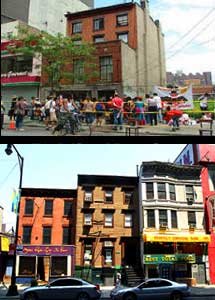An attempt to discredit historical evidence of
Abolitionist and Underground Railroad Activity
Finally a newspaper has tried to defend the Economic Development Corporation attempt to confiscate and demolish the seven homes linked to the Abolitionist movement in Downtown Brooklyn. The opinion piece, Taking license with slavery, published June 23, 2007, makes several strong claims and challenges the motivations of those trying to promote the Abolitionist heritage.
“A Key Component of the Area’s Rebirth”?
The thesis of the article is that preservationists are trying to “block a key componenent of the areas’ rebirth.” Unfortunately, the Daily News fails to explain why these properties are “a key component.” It would be very interesting to hear how this proposed grassy knoll is essential to Brooklyn’s economy.
Given the lack of specifics by the Daily News, I am reminded of the exact same claims by the EDC in the City Council hearing on the subject of May 1, 2007. At the hearing, Council Representative Liu spent several minutes trying to ask the EDC representative if, in fact, the Downtown Brooklyn plan could proceed without this property. EDC Vice President Thomas McKnight tried to avoid anwering Liu’s yes-or-no question, but in the end, he admitted that the EDC plan can proceed without the properties.
The Daily News itself gives many examples of how Downtown Brooklyn is experiencing astounding economic development without a grassy knoll and parking lot at the site of these seven homes. In their words, “Billions of private dollars have been committed to projects ranging from skyscrapers to affordable housing.”
It's possible that another parking lot would also greatly help Downown Brooklyn, but why is eminent domain necessary for this? If the two impressive new hotels going up across the street from 227 Duffield need parking, why can't they build it themselves?
Let me make a simple request of the Daily News. Please explain how these billions of dollars of investments are threatened by the Duffield Street Seven?
Independent Research?
Given the weak argument of the benefits of destroying these privately owned homes and businesses, the Daily News goes on to attack the defenders of the Abolitionist homes. In response to advocates' claims that the EDC "failed to adequately research the possibility that the buildings once harbored runaway slaves," the article states:
"In fact, the city bent over backward to do just that, commissioning a $500,000 study by independent researchers and historians. The conclusion: A family active in the abolitionist movement once lived there, but there is no proof the houses hid fugitives. [emphasis added]
The City may have bent over backward, but that doesn't mean they successfully proved their point. The EDC hired AKRF to do this research, and AKRF was hired without competitive bidding. This raises questions about their independence, especially since AKRF has never said who the "independent" researchers are. The EDC report published in March 2007 and written by AKRF, goes into great detail about the qualifications of the historians hired as peer reviewers. But these well-respected academics were only reviewing the work of the researchers who wrote the report. Nowhere does AKRF or the EDC name the researchers. Only AKRF can say what their qualifications are, and whether they are in fact independent. But AKRF is not speaking, and the EDC is not asking.
The Daily News article parallels the EDC’s attempt to frame the historical discussion. There is no debate that the area around Duffield Street was a known Abolitionist neighborhood at a time when most of New York was pro-slavery. One local resident, a poet and reporter named Walt Whitman, wrote vividly about an escaped slave coming to his house in a book called Leaves of Grass (1855). The Daily News and the EDC try to fall back on the argument that there is no verifiable evidence that slaves hid in the basements of these properties. The Underground Railroad was a very secretive movement, and the EDC does not claim that slaves did not hide in these basements. It only says that there is no proof that they did.
The historians hired by AKRF did come to the conclusion that the properties should be preserved. The EDC conclusion contradicts the peer reviewers published statements calling for further research. Even the Executive Summary of the AKRF/EDC admits that more evidence of Underground Railroad activity could be discovered.
Historians like Dr. Cheryl LaRoche, who was hired by AKRF to legitimize their report, have dedicated their lives to researching the Abolitionist movement and the Underground Railroad. Dr. LaRoche, who is much more respected in this field than the EDC or the Daily News, has stated that Duffield Street represents the best site for possible Underground Railroad in New York City. She says that it is one of the most promising sites that she has ever evaluated.
Nobody debates that this is the best documented potential Underground Railroad site in New York City.
Even if it is impossible to prove that fugitive slaves hid in the basement, the homes still might be an important part of Abolitionist history.
Representatives Liu, James and Barron are not denouncing the report “simply because they say so.” You could almost say that the report denounces itself. Its Executive Summary seems to contradict the Appendices.
Working Together to Promote New York
The EDC’s stated goal is to have a diverse and vibrant economy. A parking lot may attract a few people, but in the long run, the New York economy would be better off with a museum for our proud Abolitionist history on Duffield Street.
The Daily News says that promoters of Abolitionist history are "cynically playing on the charged issue of the city's slave past." If the Daily News has to resort to this sort name-calling, then it looks like the argument in favor of the parking lot is weak. If the EDC is going to confiscate possibly historic private property, the burden of proof of the benefit must be high.





